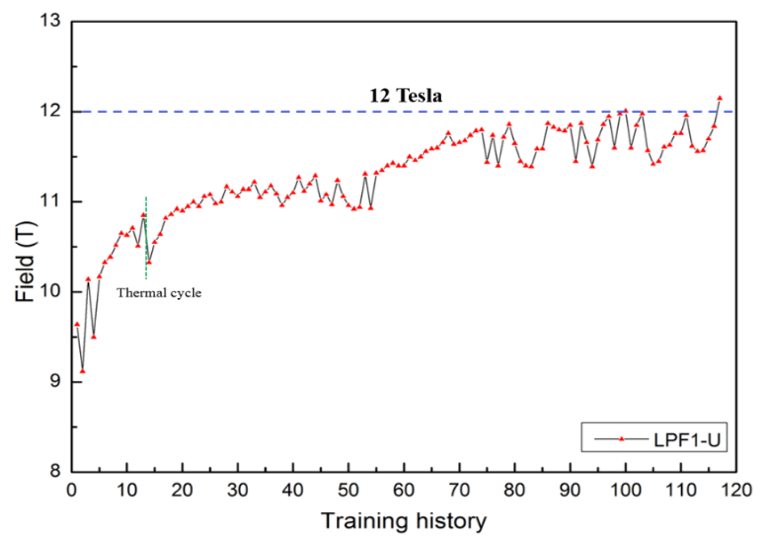Domestic Superconducting Dipole Magnet Reaches 12 Tesla
The high-field superconducting magnet team of IHEP has made breakthrough progress in a new round of performance tests that ended on June 13. The magnetic field of the dipole magnet developed by the team exceeded 12 T (Tesla) in two apertures at 4.2 K, reaching more than 85% of the critical performance capacity of the superconducting wire. The development of this magnet is based on domestic technology—from the design, superconducting materials, cables and coils, to the related equipment and platform.
At present, the magnetic field record for a dipole magnet without aperture is 16 T and is held by CERN. The record for a single-aperture dipole magnet is 14 T and was just achieved by Fermilab in 2020. An achievement of 12 T with twin aperture is at the forefront of the field. Furthermore, this magnet is currently the only one in the world that uses a combination of different superconducting materials to achieve a 12 T dipole field strength. It is a milestone in the development of advanced high field accelerator magnets in China.
Lucio Rossi, former project leader of the CERN Large Hadron Collider High Luminosity Upgrade (HL-LHC) and current professor of physics at the University of Milan, Luca Bottura, former leader of the CERN MSC research group, current leader Arnaud Devred, and Akira Yamamoto, former head of the Cryogenics Sciences Center of KEK, Japan, along with other international colleagues, sent congratulatory letters to the IHEP team, with comments such as "fantastic result in demonstrating the common coil advantages and also with the combined coil design," "very good progress in the 10T+ field," and "very nice achievement," etc.
The strong magnetic field provided by the high-field superconducting magnet can control the trajectory and size off the high-energy charged particle beam, which is the core requirement of basic physics research, advanced nuclear fusion energy technology, and high-energy particle accelerator construction, etc. High-field superconducting magnet technology is listed as one of the top priority core technologies for the development of high-energy physics in Europe and the United States over the next ten years.
Fusion reactor R&D programs being carried out internationally and domestically also strongly rely on high-field magnet technology. The next-generation high-field superconducting magnets with greatly improved performance are also expected to be widely used in high-precision medical systems, low-loss electrical systems, and transportation systems, etc., thus boosting national public health, the realization of carbon neutral goals, and the related formation of high-tech industrial clusters.
This research work has been supported by the Strategic Priority Research Program of the Chinese Academy of Sciences (Grant No. XDB25000000) and the National Key R&D Program of China (Grant No. 2018YFA0704200).

Contact Information
Mr. GUO Lijun
ljguo@ihep.ac.cn